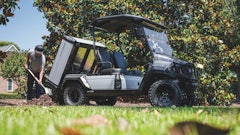
Green consumerism is on the rise, and in turn so, is green marketing. As more and more manufacturers tout their sustainable products, and dealers use sustainable operating as a way to attract environmentally conscious customers, proper green marketing is essential.
With the increase in businesses marketing their sustainability, green marketing is not as simple as it once was. You cannot just slap the word "green" on your marketing materials and stand by as the sales sky-rocket. More consumers are calling claims of green products and operations into question. If you are forthright in your marketing message, you can reap the benefits.
Honest marketing
It is important to keep your level of green marketing in line with your actual green operation. You should always avoid "greenwashing", or overstating the environmental benefits of a product or service you provide as well as the level of sustainability practiced in your operation.
Give customers a clear view of your products and operations so they can see the bad with the good. For example, let them know that while you might use energy-efficient bulbs in the dealership, you have not quite reached paperless status. If that is your goal, share that information with them. Tell them why it is important to you and how you wish to achieve it, and by when.
Know your green customers
Before you start marketing your green products and services, you should know who your environmentally conscious customers are and what level of marketing is required to attract them to your green offerings.
To learn more about who your potential green customers are, conduct surveys inquiring about their green-buying habits. What do they look for in a business that claims to be sustainable? Learn their desires so you know best how to communicate the benefits of dealing with your business to them. You may also learn new ways that you can improve your sustainable efforts.
According to the Natural Marketing Institute's (NMI) Lifestyles of Health and Sustainability (LOHAS) Consumer Trends Database, more than 80% of the total U.S. adult population shows some type of "green motivation".
The level of motivation among these consumers varies, and so do their buying habits. LOHAS lists the five following types of consumers:
Lifestyles of Health and Sustainability (LOHAS) – early adopters and trendsetters driven by a sense of social responsibility. They make up 18% of the population and are active stewards of the environment, dedicated to personal and planetary health. LOHAS consumers are the heaviest purchasers and influencers of the green/socially responsible products.
Naturalites – Individuals motivated by personal wellness and a desire to live a healthy lifestyle
Drifters – Trend followers who want to be seen participating in the green movement but lack genuine concern for the environment
Conventionals – Individuals who have sustainable habits, like reusing grocery store bags, but are more motivated by their desire to save money and reduce waste than they are by social responsibility
Unconcerned – Those not involved or engaged with environmental issues.
Pinpoint which category each of your customers fits into and adjust your marketing efforts accordingly. As sustainable products are becoming more mainstream, individuals from each of these categories are buying them. The difference, however, is the level of green marketing required to attract them.
Share responsibility
Go one step beyond offering customers sustainable products and services, and share some of that environmental responsibility with them. Not only do customers appreciate when a dealer acts as a resource for them, but green consumers will appreciate your knowledge of sustainable living. Provide customers with information on how to operate sustainably and offer them solutions for execution with your products and services.
According to NMI's 2011 LOHAS database, 13% of survey respondents had purchased environmentally friendly lawn and garden products in the 12 months prior. Additionally, 7% had purchased environmentally friendly pest control products. The report also states that 75% of those surveyed are interested in buying lawn and garden products that are green or environmentally friendly.
You should also reach out to manufacturers for extensive literature on how environmentally friendly their products are, as well as the most sustainable way to operate them as far as run-time, maintenance and fuel. They should also be able to provide information on equipment recycling.


![Gravely Pro Turn Mach One My23 Dsc03139 Edit 1200x800 5b2df79[1]](https://img.greenindustrypros.com/mindful/acbm/workspaces/default/uploads/2025/10/gravely-pro-turn-mach-one-my23-dsc03139-edit-1200x800-5b2df791.BucBnDoN22.jpg?auto=format%2Ccompress&fit=crop&h=100&q=70&w=100)








![Gravely Pro Turn Mach One My23 Dsc03139 Edit 1200x800 5b2df79[1]](https://img.greenindustrypros.com/mindful/acbm/workspaces/default/uploads/2025/10/gravely-pro-turn-mach-one-my23-dsc03139-edit-1200x800-5b2df791.BucBnDoN22.jpg?ar=16%3A9&auto=format%2Ccompress&fit=crop&h=135&q=70&w=240)







